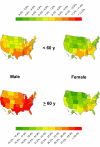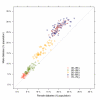Diabetes prevalence and diagnosis in US states: analysis of health surveys - PubMed (original) (raw)
Diabetes prevalence and diagnosis in US states: analysis of health surveys
Goodarz Danaei et al. Popul Health Metr. 2009.
Abstract
Background: Current US surveillance data provide estimates of diabetes using laboratory tests at the national level as well as self-reported data at the state level. Self-reported diabetes prevalence may be biased because respondents may not be aware of their risk status. Our objective was to estimate the prevalence of diagnosed and undiagnosed diabetes by state.
Methods: We estimated undiagnosed diabetes prevalence as a function of a set of health system and sociodemographic variables using a logistic regression in the National Health and Nutrition Examination Survey (2003-2006). We applied this relationship to identical variables from the Behavioral Risk Factor Surveillance System (2003-2007) to estimate state-level prevalence of undiagnosed diabetes by age group and sex. We assumed that those who report being diagnosed with diabetes in both surveys are truly diabetic.
Results: The prevalence of diabetes in the U.S. was 13.7% among men and 11.7% among women >/= 30 years. Age-standardized diabetes prevalence was highest in Mississippi, West Virginia, Louisiana, Texas, South Carolina, Alabama, and Georgia (15.8 to 16.6% for men and 12.4 to 14.8% for women). Vermont, Minnesota, Montana, and Colorado had the lowest prevalence (11.0 to 12.2% for men and 7.3 to 8.4% for women). Men in all states had higher diabetes prevalence than women. The absolute prevalence of undiagnosed diabetes, as a percent of total population, was highest in New Mexico, Texas, Florida, and California (3.5 to 3.7 percentage points) and lowest in Montana, Oklahoma, Oregon, Alaska, Vermont, Utah, Washington, and Hawaii (2.1 to 3 percentage points). Among those with no established diabetes diagnosis, being obese, being Hispanic, not having insurance and being >/= 60 years old were significantly associated with a higher risk of having undiagnosed diabetes.
Conclusion: Diabetes prevalence is highest in the Southern and Appalachian states and lowest in the Midwest and the Northeast. Better diabetes diagnosis is needed in a number of states.
Figures
Figure 1
Estimated prevalence of total diabetes by state, sex, and age group. Within each age group, figures are age-standardized to the 2000 U.S. population.
Figure 2
Relationship between male and female diabetes prevalence, by age. Each data point corresponds to one state.
Similar articles
- The nurse practitioner in family planning services: law and practice.
Roemer R. Roemer R. Fam Plann Popul Rep. 1977 Jun;6(3):28-34. Fam Plann Popul Rep. 1977. PMID: 12259979 - Family planning funds increased tenfold since FY 1971 while staff remained constant.
[No authors listed] [No authors listed] Fam Plann Popul Rep. 1977 Oct;6(5):62-5. Fam Plann Popul Rep. 1977. PMID: 12308833 - Illinois, Massachusetts: governors veto restrictions on state funds for abortion.
[No authors listed] [No authors listed] Fam Plann Popul Rep. 1977 Oct;6(5):57-9. Fam Plann Popul Rep. 1977. PMID: 12308832 - Prevalence and Incidence of Type 2 Diabetes and Prediabetes.
Cowie CC, Casagrande SS, Geiss LS. Cowie CC, et al. In: Cowie CC, Casagrande SS, Menke A, Cissell MA, Eberhardt MS, Meigs JB, Gregg EW, Knowler WC, Barrett-Connor E, Becker DJ, Brancati FL, Boyko EJ, Herman WH, Howard BV, Narayan KMV, Rewers M, Fradkin JE, editors. Diabetes in America. 3rd edition. Bethesda (MD): National Institute of Diabetes and Digestive and Kidney Diseases (US); 2018 Aug. CHAPTER 3. In: Cowie CC, Casagrande SS, Menke A, Cissell MA, Eberhardt MS, Meigs JB, Gregg EW, Knowler WC, Barrett-Connor E, Becker DJ, Brancati FL, Boyko EJ, Herman WH, Howard BV, Narayan KMV, Rewers M, Fradkin JE, editors. Diabetes in America. 3rd edition. Bethesda (MD): National Institute of Diabetes and Digestive and Kidney Diseases (US); 2018 Aug. CHAPTER 3. PMID: 33651562 Free Books & Documents. Review. - Sociodemographic Characteristics of Persons With Diabetes.
Eberhardt MS, Casagrande SS, Cowie CC. Eberhardt MS, et al. In: Cowie CC, Casagrande SS, Menke A, Cissell MA, Eberhardt MS, Meigs JB, Gregg EW, Knowler WC, Barrett-Connor E, Becker DJ, Brancati FL, Boyko EJ, Herman WH, Howard BV, Narayan KMV, Rewers M, Fradkin JE, editors. Diabetes in America. 3rd edition. Bethesda (MD): National Institute of Diabetes and Digestive and Kidney Diseases (US); 2018 Aug. CHAPTER 8. In: Cowie CC, Casagrande SS, Menke A, Cissell MA, Eberhardt MS, Meigs JB, Gregg EW, Knowler WC, Barrett-Connor E, Becker DJ, Brancati FL, Boyko EJ, Herman WH, Howard BV, Narayan KMV, Rewers M, Fradkin JE, editors. Diabetes in America. 3rd edition. Bethesda (MD): National Institute of Diabetes and Digestive and Kidney Diseases (US); 2018 Aug. CHAPTER 8. PMID: 33651553 Free Books & Documents. Review.
Cited by
- Examining Diabetes Status by the Social Determinants of Health Among Adults in Hawai'i.
Aguiar C, Hurwitz EL, Wu YY, Yamanaka AB. Aguiar C, et al. Hawaii J Health Soc Welf. 2024 Aug;83(8):216-224. doi: 10.62547/GDHV1853. Hawaii J Health Soc Welf. 2024. PMID: 39131831 Free PMC article. - Mortality and morbidity ramifications of proposed retractions in healthcare coverage for the United States.
Pandey A, Fitzpatrick MC, Singer BH, Galvani AP. Pandey A, et al. Proc Natl Acad Sci U S A. 2024 Apr 30;121(18):e2321494121. doi: 10.1073/pnas.2321494121. Epub 2024 Apr 22. Proc Natl Acad Sci U S A. 2024. PMID: 38648491 Free PMC article. - The Use of Digital Telehealth for the Self-Management of Type 2 Diabetes Patients in Hinds County, Mississippi: A Pilot Study.
Onyia AU, Berhie G, Cecchetti A, Hines A. Onyia AU, et al. J Patient Exp. 2023 Oct 3;10:23743735231188835. doi: 10.1177/23743735231188835. eCollection 2023. J Patient Exp. 2023. PMID: 37817929 Free PMC article. - Bayesian Multistate Life Table Methods for Large and Complex State Spaces: Development and Illustration of a New Method.
Lynch SM, Zang E. Lynch SM, et al. Sociol Methodol. 2022 Aug;52(2):254-286. doi: 10.1177/00811750221112398. Epub 2022 Jul 23. Sociol Methodol. 2022. PMID: 37284595 Free PMC article. - Assessing Phenotype Definitions for Algorithmic Fairness.
Sun TY, Bhave SA, Altosaar J, Elhadad N. Sun TY, et al. AMIA Annu Symp Proc. 2023 Apr 29;2022:1032-1041. eCollection 2022. AMIA Annu Symp Proc. 2023. PMID: 37128361 Free PMC article.
References
- Centers for Disease Control and Prevention NCfHS. National Health and Nutrition Examination Survey data sets and related documentation (Survey Questionnaire, Examination and Laboratory Protocols, 1988-1994 and 1999-2002) 2002.
- Nelson DE, Holtzman D, Bolen J, Stanwyck CA, Mack KA. Reliability and validity of measures from the Behavioral Risk Factor Surveillance System (BRFSS) Soz Praventivmed. 2001;46(Suppl 1):S3–42. - PubMed
LinkOut - more resources
Full Text Sources

